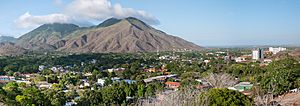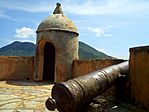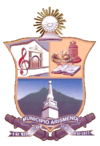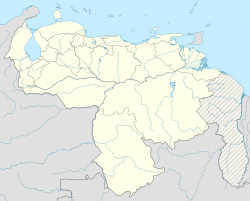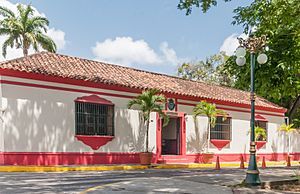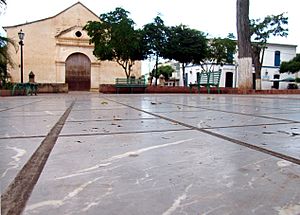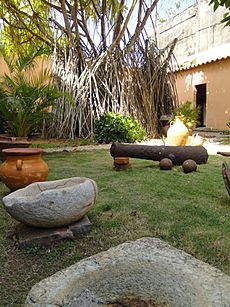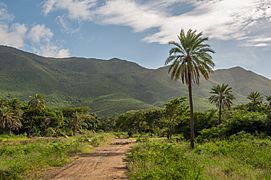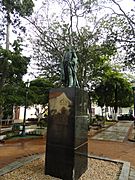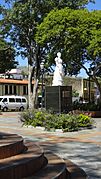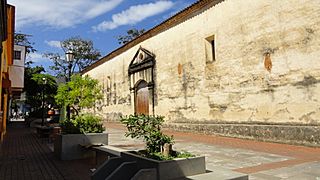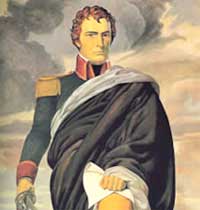La Asunción facts for kids
Quick facts for kids
La Asunción
|
|||
|---|---|---|---|
|
City
|
|||
|
Panoramic, Castle of Santa Rosa and House of La Asunción.
|
|||
|
|||
| Country | |||
| State | Nueva Esparta | ||
| Municipality | Arismendi Municipality | ||
| Elevation | 42 m (138 ft) | ||
| Population
(2011)
|
|||
| • Total | 28,513 | ||
| Time zone | UTC−4 (VET) | ||
| Area code(s) | 0295 | ||
| Demonym | Asuntino/a | ||
| Climate | BSh | ||
La Asunción is a historic city in Venezuela. It is the capital of Nueva Esparta state, which is made up of three islands. La Asunción is located on Margarita Island in the Caribbean Sea, just off the coast of South America.
The city sits in a green valley surrounded by hills. It is about 6 kilometers (4 miles) inland from the port of Porlamar. This inland location gives it a slightly cooler climate. Captain Pedro González Cervantes de Albornoz founded the city in 1565. A large fortress, Santa Rosa de la Eminencia castle, stands behind the city, built long ago to protect it. Many important buildings in La Asunción are found around Plaza Bolívar. The Catedral Nuestra Señora de La Asunción, built in the 1500s, is one of Venezuela's oldest churches. In 2011, the city had a population of 28,513 people.
Contents
History of La Asunción
In 1562, Spanish villagers moved to this area to escape attacks from pirates. However, the village was completely destroyed by French pirates in 1566 and later by the English privateer John Hopkins. Despite these attacks, the town was rebuilt, given a coat of arms, and officially became a city.
Captain Pedro González Cervantes de Albornoz founded La Asunción in 1565. To better protect the city, the Santa Rosa de la Eminencia castle was built on a hill overlooking it. Construction began in 1677 and finished around 1683. La Asunción played a role in the Venezuelan War of Independence. A famous general, Juan Bautista Arismendi, married his wife Luisa Cáceres de Arismendi in the city on December 4, 1814. The castle was left unused for a while but later became a War Museum in 1955. It was declared a National Monument in 1965.
Geography and Location
La Asunción is located in the Santa Lucia Valley, in the middle of eastern Margarita Island. Green hills surround the city. The city of Porlamar is about 6 miles (10 kilometers) to the south. When La Asunción was founded, its hidden location helped protect it from pirates along the coast. The fertile Santa Lucia Valley gets its water from the nearby Cerro El Copey mountains. A bridge over the Río Asunción was built in 1609, which served as the main entry to the town from the north until 1970.
Population of La Asunción
La Asunción is part of the state of Nueva Esparta. In 1981, its population was 10,375. By October 2010, the population had grown to 28,309 people.
Exploring the City
La Asunción has important services like banks, a post office, and a modern private hospital. The Palacio Municipal, which holds the state government offices, is located behind the main cathedral. The Assemblea Legislativa, where laws are made, is in an old Franciscan monastery that was once a hospital and a prison. You can still see an old sundial from 1612 there.
The main city square is divided into two parts. The southern part is named after Simón Bolívar, a famous Venezuelan hero. The northern part is named after Luisa Cáceres de Arismendi, another important historical figure, and has her statue. An old two-story house has been turned into a souvenir shop and coffee spot. The house where independence hero Juan Bautista Arismendi was born has also been restored.
Getting Around
By Air
La Asunción is about 30 kilometers (18 miles) from Santiago Mariño Caribbean International Airport. This airport has flights to mainland Venezuela and some international charter flights.
By Sea
Ferry services are available from a terminal about 40 kilometers (25 miles) southwest in Punta de Piedras. You can take a ferry to cities like Puerto La Cruz, Guanta, and La Guaira on mainland Venezuela. There are also ferries to Coche Island.
Famous Landmarks
Some of the most important landmarks in La Asunción include the Catedral Nuestra Señora de la Asunción, the Santa Rosa castle, the Museo Nueva Cádiz, the Casa de la Cultura, and Cerro El Copey National Park.
Catedral Nuestra Señora de La Asunción
Built between 1570 and 1612, the Catedral Nuestra Señora de La Asunción is the oldest church still standing in Venezuela. Its construction began in 1570. A new church started in 1609 and took 10 years to finish. The church has strong, thick walls to protect against pirate attacks. Two rows of large pillars support the roof. There is a separate bell tower outside, and its bells are now kept in the plaza. The cathedral is dedicated to Our Lady of the Assumption. It has a simple look, but its left tower, built in 1599, is the oldest in the country. The most important festival here is in mid-August, celebrating the Feast of the Assumption with a procession and church service.
Castle of Santa Rosa de la Eminencia
The Santa Rosa de la Eminencia castle was built in 1682. Because it sits on a hill, it was a great lookout point for spotting any invaders coming from the north, south, or east. A long tunnel, about a kilometer (0.6 miles) long, connected the fort to the governor's house, the church, and the Convent of San Francisco. This fort, along with two others, helped protect the island from English, French, Dutch, and other colonizers.
This castle is famous because Luisa Cáceres de Arismendi, the brave wife of freedom fighter Juan Bautista Arismendi, was held prisoner here. She was captured in 1816 when she was just 16 years old. The Spanish hoped that by capturing her, her husband would surrender, but their plan failed. Luisa became a local heroine for her courage. The cell where she was held is still preserved. An inscription at the cell's entrance honors her bravery. The fort also displays old weapons, paintings, and iron balls used for prisoners. There's even a hidden dungeon behind the kitchen. From the fort, you get amazing views of the sea and Cerro Matasiete.
Museum Nueva Cádiz
The Casa Capitular, which used to be the colonial government's headquarters and city hall, is now the Museo Nueva Cádiz (New Cádiz Museum). It shows off ancient artifacts from before the Spanish arrived and local crafts. On May 4, 1810, this building was where Margarita declared its independence, following a similar declaration in Caracas. The museum also has a gallery and a library.
One interesting display in the museum is a sculpture of Lope de Aguirre, a historical figure who caused trouble for the islanders in 1561.
Casa de Juan Bautista Arismendi
The Casa de Juan Bautista Arismendi is a house that honors Juan Bautista Arismendi, a Venezuelan war hero.
Casa de la Cultura
The Casa de la Cultura is across from the church and has a theater. It displays a collection of pottery from before Columbus arrived. You can buy copies of these pottery pieces in the nearby town of Santa Ana.
Cerro El Copey National Park
Cerro El Copey National Park on Margarita Island is very important because it is home to many unique plant and animal species found nowhere else. The island was once connected to the mainland. This means it has many bird families typically found on continents, which are rare on other Caribbean islands. About 31 types of mammals live on the island. Four of these, including a type of red-tailed squirrel, a rabbit, a white-tailed deer, and a capuchin monkey, are special subspecies found only here. The Margarita capuchin monkey is considered one of Venezuela's most endangered primates.
Gallery
Notable people
- Juan Fermín de Huidobro (1783-1853) - a governor of Margarita
- Francisco Esteban Gómez (1783-1853) - a military leader who passed away in La Asunción
- Modesta Bor (1926-1998) - a composer
- Luis Beltrán Prieto Figueroa (1902-1993) - a national politician
- Juan Bautista Arismendi (1775-1841) - a revolutionary general during the War of Independence
- Luisa Cáceres de Arismendi (1799-1866) - a heroine of the War of Independence
- José Enrique “Chelique” Sarabia - a singer and songwriter
See also
 In Spanish: La Asunción para niños
In Spanish: La Asunción para niños


